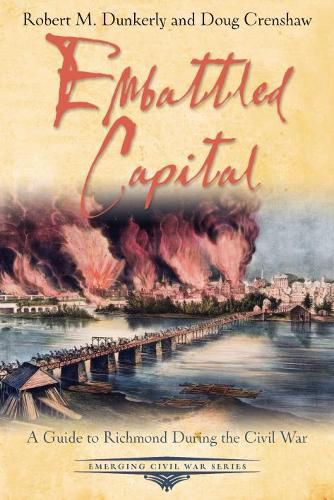Readings Newsletter
Become a Readings Member to make your shopping experience even easier.
Sign in or sign up for free!
You’re not far away from qualifying for FREE standard shipping within Australia
You’ve qualified for FREE standard shipping within Australia
The cart is loading…






On To Richmond! cried editors for the New York Tribune in the spring of 1861. Thereafter, that call became the rallying cry for the North’s eastern armies as they marched, maneuvered, and fought their way toward the capital of the Confederacy. Just 100 miles from Washington, DC, Richmond served as a symbol of the rebellion itself. Richmond was home to the Confederate Congress, cabinet, president, and military leadership. And it housed not only the Confederate government but also some of the Confederacy’s most important industry and infrastructure. The city was filled with prisons, hospitals, factories, training camps, and government offices. Through four years of war, armies battled at its doorsteps - and even penetrated its defenses. Civilians felt the impact of war in many ways: food shortages, rising inflation, a bread riot, industrial accidents, and eventually, military occupation. To this day, the war’s legacy remains deeply written into the city and its history. On to Richmond!: Richmond During the Civil War by historians Doug Crenshaw and Robert M. Dunkerly tells the story of the Confederate capital before, during, and after the Civil War. This guidebook includes a comprehensive list of places to visit: the battlefields around the city, museums, historic sites, monuments, cemeteries, historical preservation groups, and more. AUTHORS: Robert M. Dunkerly is a historian, award-winning author, and speaker who is actively involved in historic preservation and research. Doug Crenshaw is a volunteer historic interpreter for the Richmond National Battlefield Park.
$9.00 standard shipping within Australia
FREE standard shipping within Australia for orders over $100.00
Express & International shipping calculated at checkout
On To Richmond! cried editors for the New York Tribune in the spring of 1861. Thereafter, that call became the rallying cry for the North’s eastern armies as they marched, maneuvered, and fought their way toward the capital of the Confederacy. Just 100 miles from Washington, DC, Richmond served as a symbol of the rebellion itself. Richmond was home to the Confederate Congress, cabinet, president, and military leadership. And it housed not only the Confederate government but also some of the Confederacy’s most important industry and infrastructure. The city was filled with prisons, hospitals, factories, training camps, and government offices. Through four years of war, armies battled at its doorsteps - and even penetrated its defenses. Civilians felt the impact of war in many ways: food shortages, rising inflation, a bread riot, industrial accidents, and eventually, military occupation. To this day, the war’s legacy remains deeply written into the city and its history. On to Richmond!: Richmond During the Civil War by historians Doug Crenshaw and Robert M. Dunkerly tells the story of the Confederate capital before, during, and after the Civil War. This guidebook includes a comprehensive list of places to visit: the battlefields around the city, museums, historic sites, monuments, cemeteries, historical preservation groups, and more. AUTHORS: Robert M. Dunkerly is a historian, award-winning author, and speaker who is actively involved in historic preservation and research. Doug Crenshaw is a volunteer historic interpreter for the Richmond National Battlefield Park.